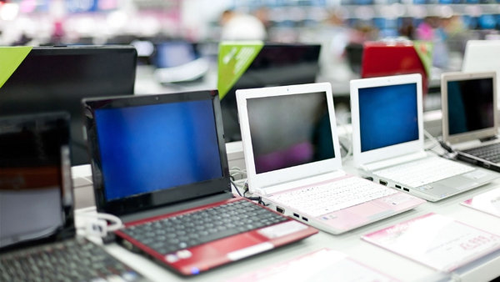With companies releasing new laptops every year, it’s getting harder to find relevant tips for buying laptops. There’s no such thing as one single “best laptop brand”, so how do you know which laptop to buy? How do you know what to look out for and what actually matters?
Below you’ll find the most important features and specifications to look for when deciding on a new laptop, explanations for those features, and whether or not they’re actually related to your specific requirements.
Let’s dive right into the real tips to buy the right laptop.

Contents
1. How much storage do I need?
What is storage, and how much storage do you need on your laptop? Storage falls into several different categories, which are outlined below.
RAM
What is RAM, and why does it matter? Well, RAM (Random Access Memory) is what your laptop uses to run any program, so more RAM is always better. But, of course, not everyone needs the highest specifications. How much RAM storage do you need?
The minimum RAM needed for the most basic document processing is 2GB, but this is far from sufficient for the average user.
A minimum of 4GB of RAM is recommended for average users running Windows. This will allow for doing things like using a web browser with a few tabs, watching videos, basic photo-editing and low-end gaming.
If you do anything more than those basic tasks, it’s recommended that you look for a laptop with at least 8GB of RAM for running Windows. This allows for most tasks and is generally the best choice for most people.
If you like to run large games on the highest settings or you’re looking for something that can handle heavyweight processing of any kind, you need 16GB or more of RAM, but this is limited to very few users.
Hard Disk
Your hard disk is where you store all your files and applications. So, it only follows that the amount of hard drive space you need directly corresponds to how many files you store.
A key point to remember is that you should leave some breathing room. Don’t count on using 100% of whatever hard disk space you have. You will also not get 100% of the space on the disk for your storage – the operating system will consume a significant amount (up to several GB for some versions of Windows), as will any applications you have installed.
For an average user, about 256GB of storage might be sufficient but you’ll almost certainly need an external hard disk to go with it. If your budget allows for it, then 500GB is a safe bet.
SSD
SSDs, or Solid-State Drives, are drives with no moving parts. So they’re a whole lot faster than traditional hard drives and last longer too. Switching from a hard disk to an SSD reduces boot time by a significant amount, software applications open significantly faster, moving large files is a breeze, you get the picture.
SSDs also consume less power, and so your laptop will have a better battery life if it has an SSD than if it has a traditional hard drive.
Laptops with SSDs are invariably a little more expensive, but if your budget allows for it then it’s the best thing to spring for. Many laptops also come with a combination of SSD storage and traditional hard drive storage.
SSDs are not a requirement but they’re a great boost and a good way to ensure your laptop stays future-proof.
2. What about graphics?
The graphics capabilities of your laptop are mainly defined by two cornerstones – the graphics memory and the graphics card.
Graphics memory may either be integrated or may be on a discrete graphics card.
- A basic user who uses simple applications and streams movies can make do with just 1GB of graphics memory, which is available on pretty much every laptop on the market.
- An average user who plays some games on low settings or does some graphic design or video-editing needs a minimum of 2GB of graphics memory.
- If you require more, 4GB will serve you well, but anything over 4GB is unnecessary for most users.
As far as graphics cards go, the integrated Intel graphics card on most laptops is enough for basic users who only use applications like MS Word and the browser. If you want a dedicated graphics card, any laptop with a graphics card in the NVIDIA 900 series is sufficient for most users (NVIDIA 920MX, 940MX).
Unlike in a PC, the graphics card in a laptop is not typically changed or upgraded, so you should pick a laptop with good enough graphics out-of-the-box for your needs. It’s important to note that cooling is one of the most important things for a graphics card, so the cooling system (like the number of fans) should be considered.
3. How do I get the best performance?
The performance or speed of your laptop is evident in how fast it boots up, how fast applications open and operate, how long file-transfers take, and the general responsiveness. A good measure of how fast your laptop will be is its processor.
The main factor to take into consideration when it comes to speed is the processor generation. It seems intuitive to assume that an Intel i7 processor will always be better than an Intel i5 processor but this is not always the case. An older i7 will almost certainly be slower than the latest i5. You can easily find the latest generation of Intel Core iX chips online, but a good rule of thumb is that it’s best to go for the most recent generation.
Another factor is processor speed – where higher is better and at least 2.5GHz is recommended, but as long as it’s a recent generation you don’t need to worry about it too much.
A factor to not consider is number of cores (unless you know how cores work). A quad-core is not always better than a dual-core, and the subject is beyond the scope of this article.
4. What size laptop should I go for?
Laptops are meant to be portable, but how portable you need your laptop to be is up to you. If you intend to carry it around every day, you might be better off picking a smaller screen size (up to 13 inches) and lighter body (around 1.5kg).
If you are not likely to carry your laptop around, you can safely go for higher screen sizes (around 15 inches) and heavier bodies (around 2.3kg).
You might also be aware of the convertible laptops that either detach from the keyboard or fold over to become a tablet. These, as fancy as they are, always trade off some other aspects to achieve this flexibility and are also typically far more expensive. It’s not recommended that you get a convertible laptop unless you’re sure that it’s a definite requirement.
5. How much will all this cost me?
A basic user can get a laptop that can handle things like Microsoft Office, web browsing, and emails for just around INR 20,000.
An average user will definitely need to spend between INR 30,000 and INR 50,000 for a laptop that meets their needs.
If you are a more advanced user with high processing or graphics requirements, it’s almost inevitable to spend anything under INR 70,000 on a high-end laptop.
Be sure to check if the price of the operating system (typically Windows) is included in the price of the laptop or not.
However, before you hike up your budget, it’s important to note that most laptops in the average price range will satisfy the requirements of all but the most advanced of users. There are many lists available online for top rated laptops at any price point.
At the end of the day, what laptop is right for you depends entirely on your requirements and your usage patterns. The best laptop brand for you depends on you. The best thing to do is to decide your budget first and then prioritize the above specs based on your requirements. There are plenty of online tools available to find top-rated laptops based on your specifications and budget, and these laptop buying tips will help you understand what you’re looking for.

